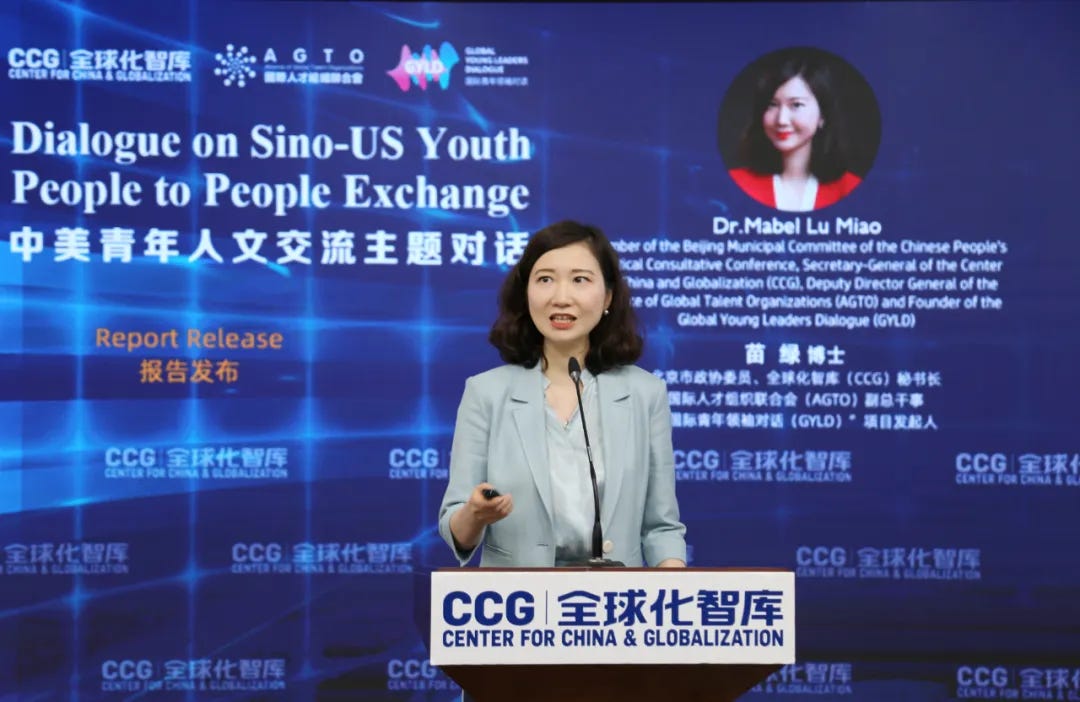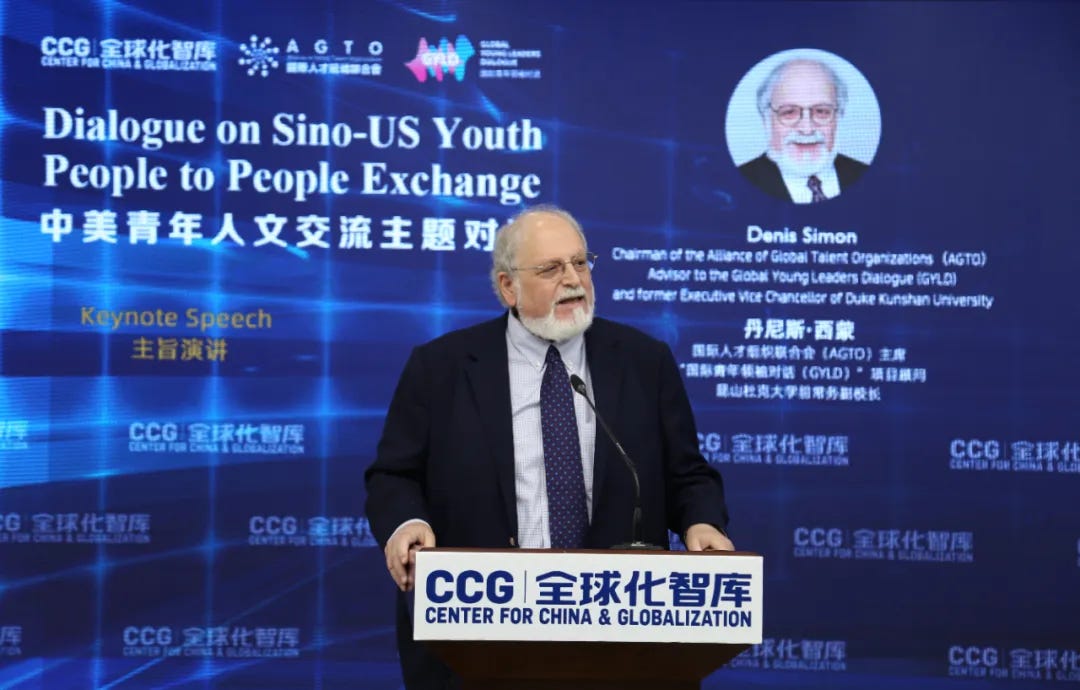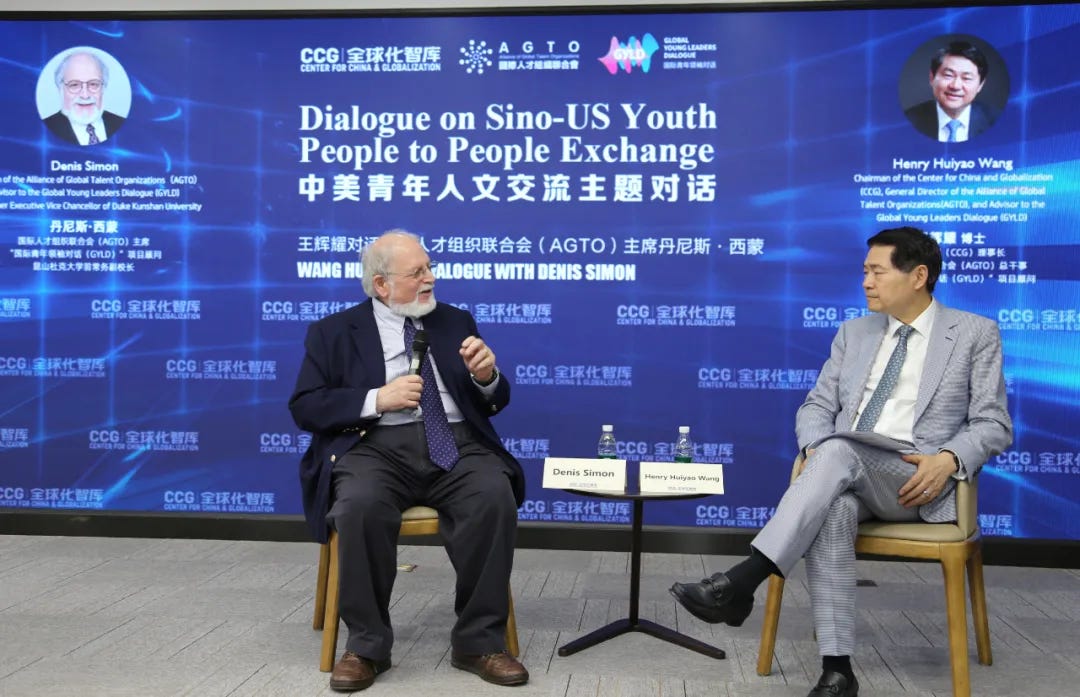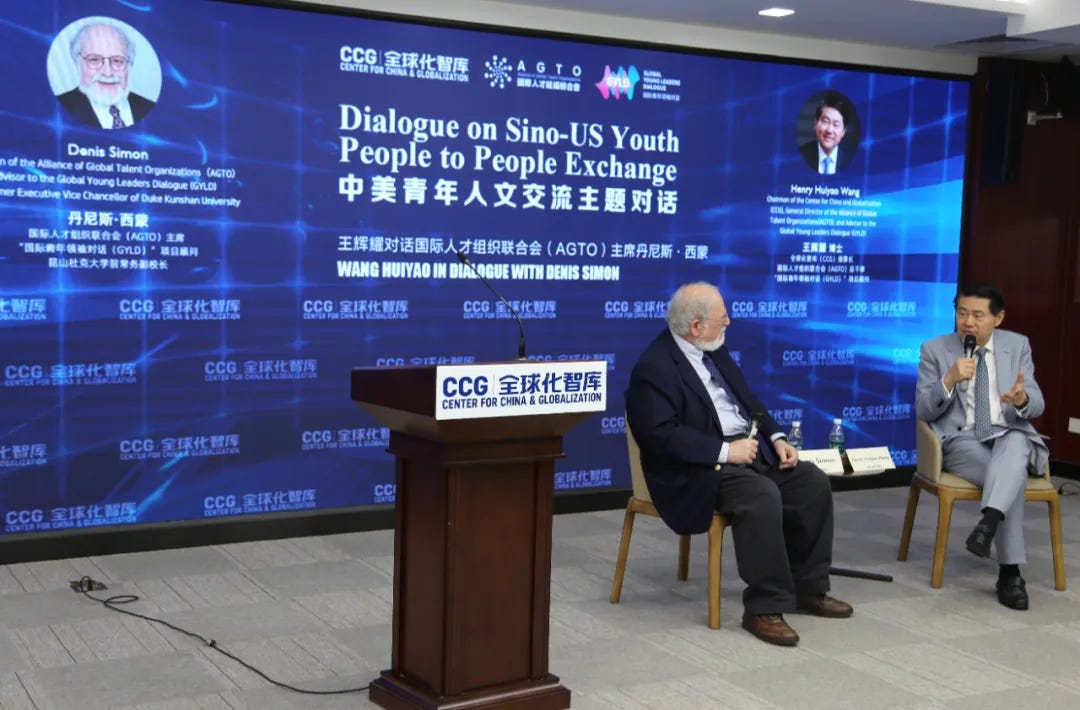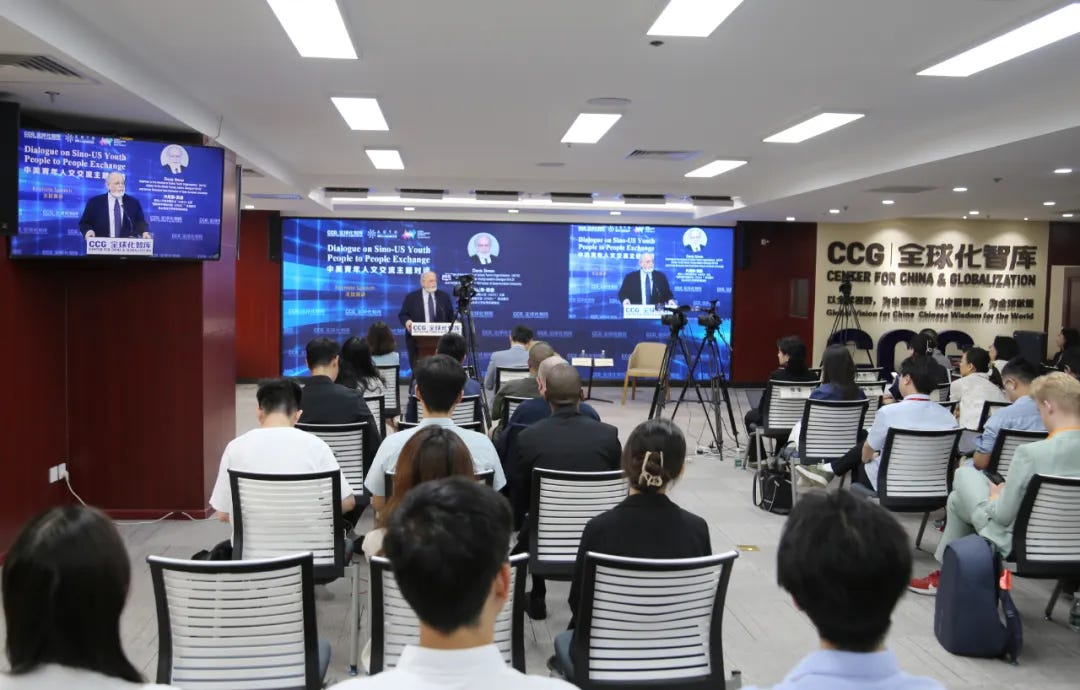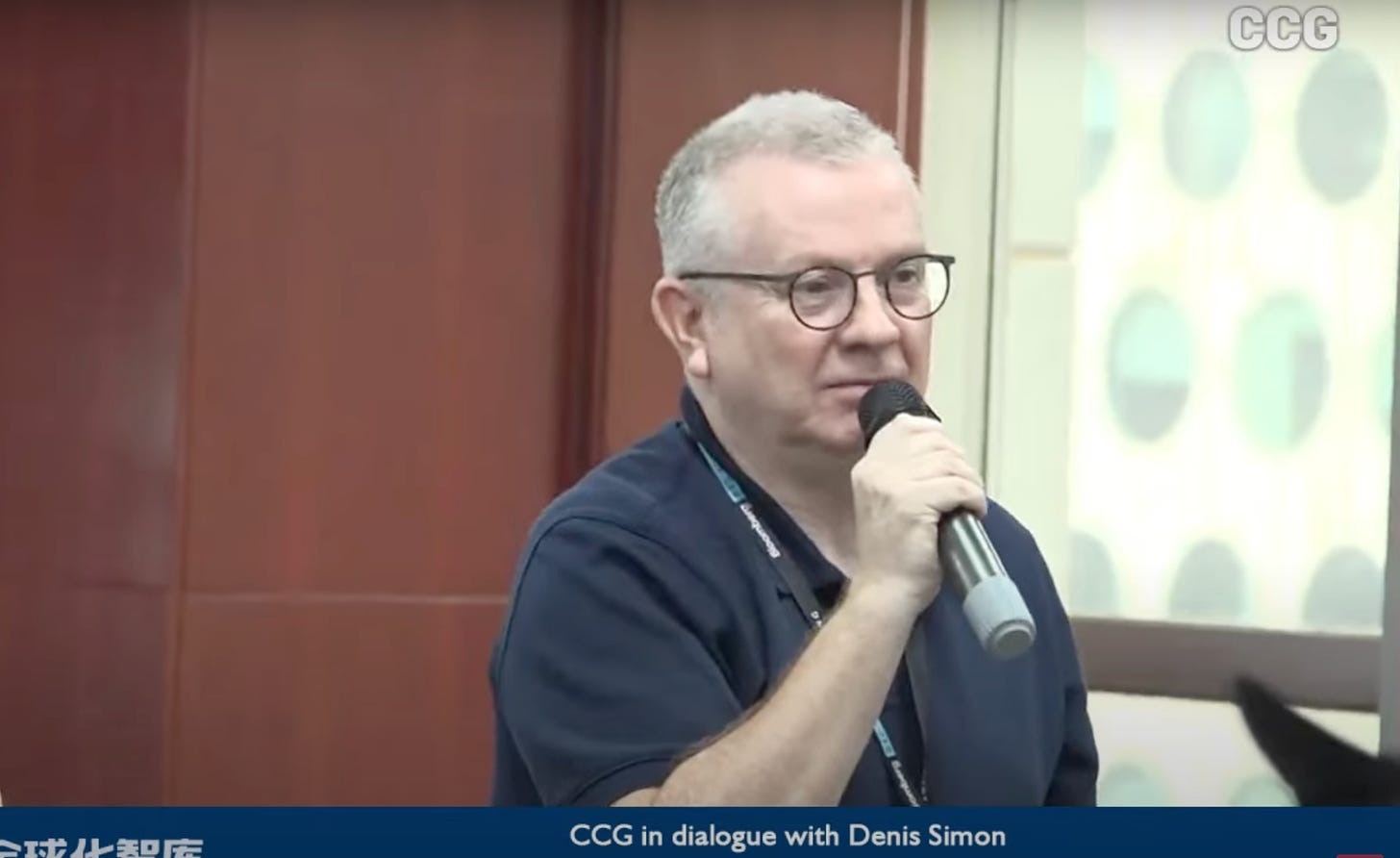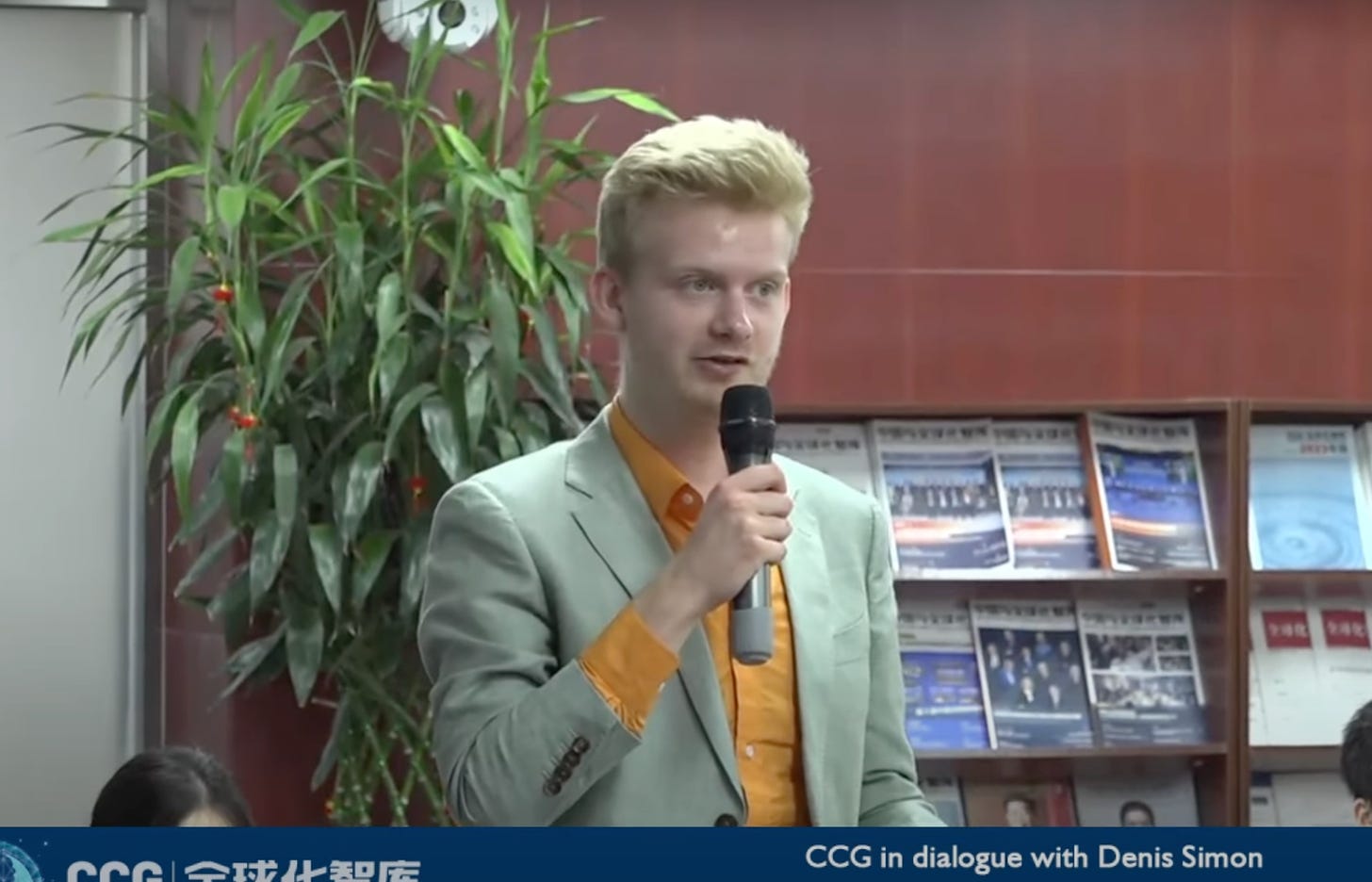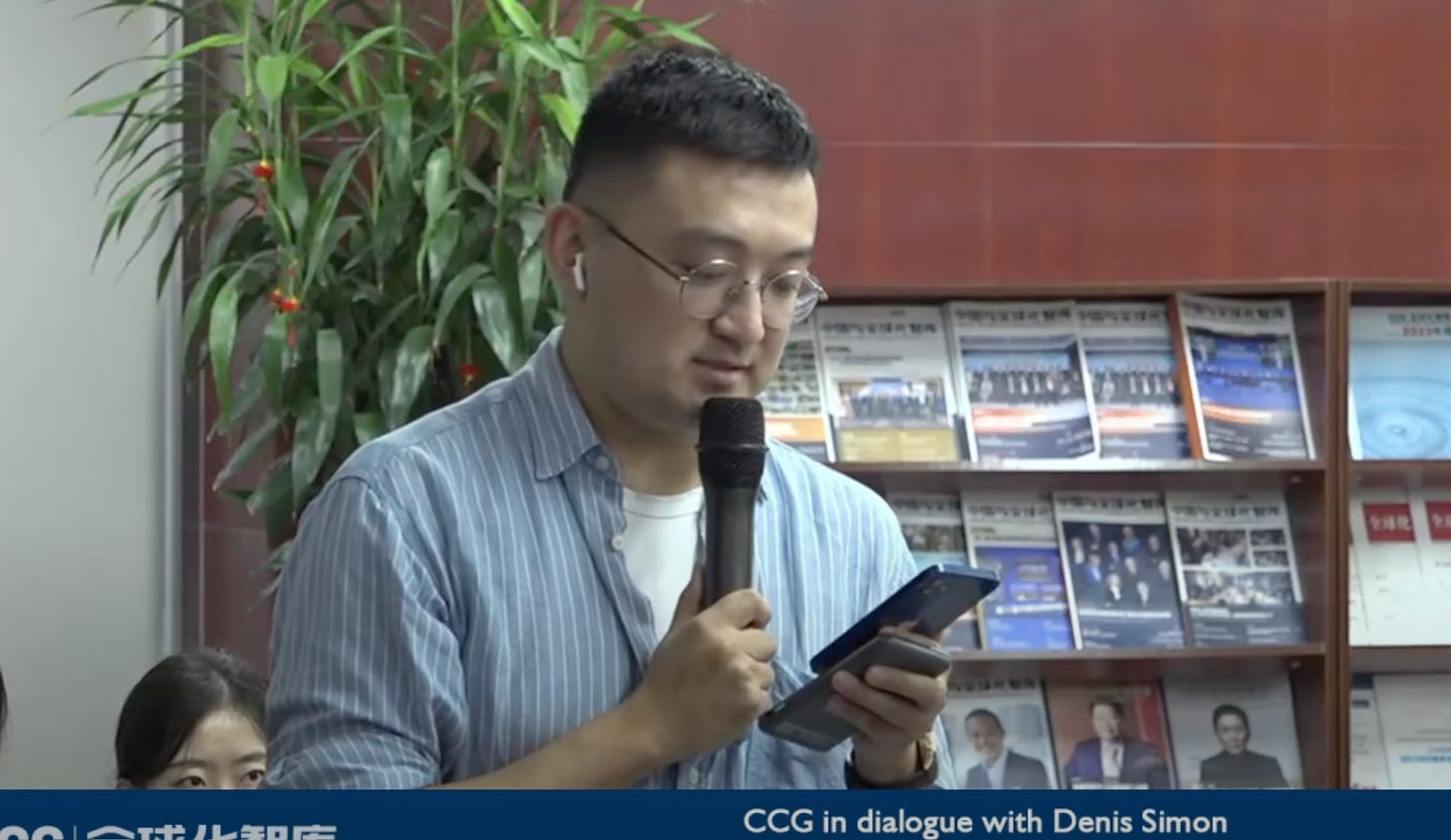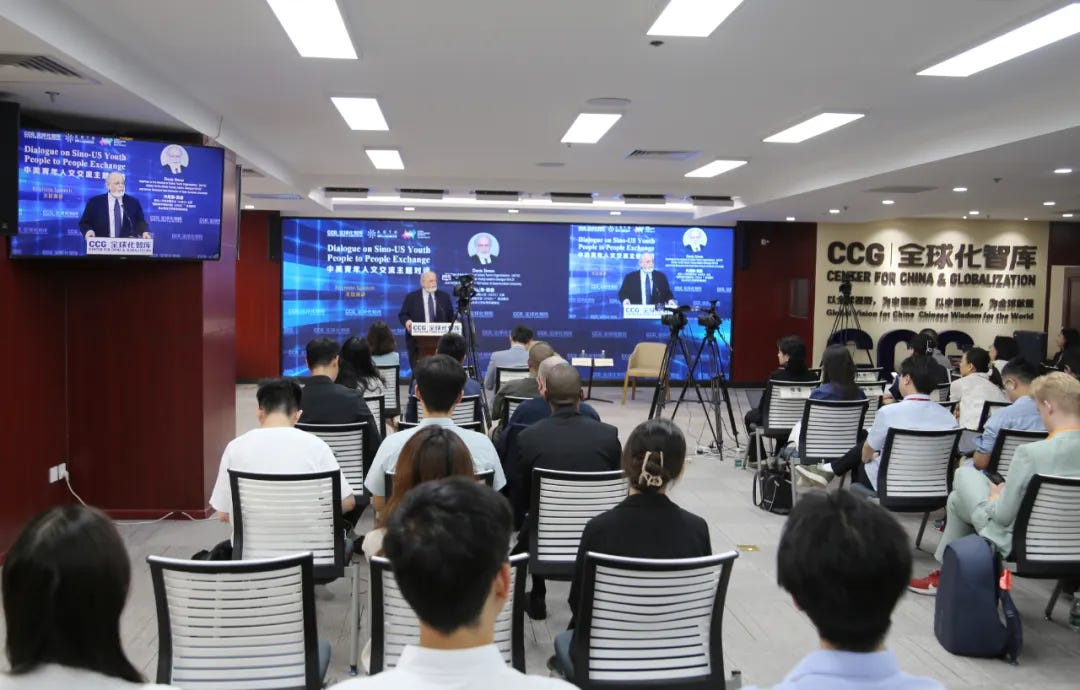Transcript of Denis Simon on Sino-U.S. youth people-to-people exchange
Former Executive Vice Chancellor of Duke Kunshan University delivered a presentation, engaged in dialogue with Huiyao Wang, and answered live questions from the audience and Chinese media.
On July 5, the Center for China and Globalization (CCG) co-hosted the latest Global Dialogue series on "Sino-US Youth People-to-People Exchange" with the Alliance of Global Talent Organizations (AGTO) and the Global Young Leaders Dialogue (GYLD) program. Denis Simon, Chairman of AGTO, advisor to the GYLD project, and former Executive Vice Chancellor of Duke Kunshan University, delivered a presentation, engaged in dialogue with Huiyao Wang, President of CCG, and answered live questions from the audience and Chinese media.
CCG has recorded the event and broadcasted the video on Chinese internet platforms, where it remains accessible. The recording is also available on YouTube.
Introduction and Report Release by Mabel Lu Miao
A summary of CCG recommendations in the report on promoting Sino-U.S. youth exchange is available in Chinese.
Keynote Speech
Denis Simon
Good afternoon, everyone, and let me thank CCG, Henry, and Mabel for organizing this event. They're always doing exciting things, so It is a pleasure when I come to Beijing to attend their events. There's always something provocative going on, so I'm doubly pleased to be here today.
To cut to the chase and get to my topic, I spent five years as the Executive Vice Chancellor at Duke Kunshan University. Part of the reason why I took the job was because I really do believe that the idea of young people from China, the US, and other countries studying, living, and working together is indeed the future. During my five-year stint there, I was impressed by the kinds of things that could happen when you invest in this kind of situation.
So it is a great pleasure for me to be here, but it is also the fact that we have entered a rather difficult time in Sino-U.S. relations, especially difficulties in the field of educational ties. It used to be the case that cooperation in science and technology and education used to be what we called the foundational elements in the bilateral relationship. Even if the government ties experienced problems, the relationship in education and in science and technology continued forward. For 35 years almost, from 1979 to 2015, you can see that the relationship was on the rise in those particular two areas.
But beginning at the end of the Obama administration and starting with, of course, the Trump administration, things began to change, and change in a rather dramatic way.
For example, the publication -- University World News -- two weeks ago issued an article entitled "How geopolitical tensions are undermining educational exchanges, student mobility, university research collaboration, etc." ["Geopolitical tensions dim prospects for US-China exchanges"] I recommend that you look at this article because I think it lays out in very great detail the extent to which the ties in education are being damaged and we need to understand that. Whether it is visa issues, interrogations at the airport, rumors of a new China initiative, the non-renewal so far of the S&T cooperation agreement and the decline in both the number of Chinese students coming to the United States and the number of U.S. students coming here to China are damaging the level, quality, and caliber of exchanges. These exchanges are vitally important for building trust and creating greater understanding between our two countries, if not today, then into the future. If we don't have this, there is going to be, I believe, some significant damage done.
This past week, unfortunately, things took yet another step in the wrong direction. Kurt Campbell, number two at the State Department in Washington D.C., made the statement that perhaps the U.S. should decide to focus Chinese students more on only social science and humanities and leave the study of STEM fields for students coming from India. The day before, it's quite interesting, Kurt Campbell was with Jake Sullivan, Biden's National Security Advisor and he was with the head of the U.S. National Science Foundation, formerly my colleague at ASU, meeting with senior Indian officers to talk about a brand new initiative in emerging technologies between the United States and India.
One could clearly see if you merge these two statements together, this was occurring at the expense of the U.S. relationship with China.
The statement by Kurt M. Campbell is quite ridiculous, in my opinion. The fact is that this is being said by the number two diplomat from the United States and cannot be ignored. Frankly, such an attempt to reconfigure educational cooperation with a lean to just India would be a disaster for the U.S. talent pipeline in the years ahead. Indeed, let's have more students from India, but let's not make it at the expense of Chinese students coming to the United States.
While all the negatives have been going on, however, I would like to provide you with much more of a positive perspective -- something that has not yet gotten a lot of attention in the media because it's been kept purposely low-profile given the nature of the political climate.
Of course, as Mabel has talked about, we must recognize the really generous offer made by President Xi to President Biden in San Francisco in November last year to host 50,000 U.S. students over five years. It was a powerful show of goodwill, and we all already have seen, I think, huge mobilization on the Chinese side, particularly with CEAIE (China Education Association For International Exchange) designated as the coordinating agency on the Chinese side.
Unfortunately, the U.S. has not designated any counterpart organization. This is the same mistake that was made back under the Obama administration when there was a 100,000 Strong initiative and that also lacked a coordinating organization to bring it into fruition.
But let me get back to the good news and some reason for some optimism, at least.
In May 2023, I organized a group of eight senior university officials to meet with the education and S&T sections at the Chinese Embassy in Washington, D.C. We met for three very productive hours and then we had a two-hour lunch with the then Chinese Ambassador who was thoroughly engaged in the discussion of trying to help revitalize educational exchanges in the post-COVID period. The May meeting was so productive that we agreed to expand it to a conversation on higher education and to create something called the U.S.-China Higher Education Dialogue with CEAIE and IIE (Institute for International Education) as counterpart agencies.
In September 2023, 14 U.S. university officials met with 15 Chinese university officials in New York City at the IIE headquarters for two and a half days to engage in very in-depth discussions about the problems, and most importantly, opportunities for future bilateral education relations. We looked at undergraduate education, graduate education, scholarly exchanges, campus issues, issues regarding joint research, and policy-related issues.
The discussions, to be honest, were very frank and very direct, but we always maintained a high level of diplomacy in carrying out discussions with one another. While we had not planned to issue any kind of press release or summary document, the success of the meeting was so strong that both sides decided to put out a summary document, and if you go to the CEAIE website or the IIE website, you can find the summary statement from this meeting.
I believe the success of this meeting derived from the fact that this was not simply a presidents' meeting; we brought together senior academic officials who had had explicit experience in Sino-U.S. bilateral relations. They understood it, they had participated in it, and understood both its potential and its difficulty. These include vice provosts for international affairs and their Chinese counterparts, vice presidents for student affairs and their Chinese counterparts, vice presidents for R&D and vice presidents for academic affairs. We all came together with lots of knowledge and experience, even when that experience was not always of a positive nature.
One major finding from this meeting, I'm happy to say, was that each side has not really done a good enough job popularizing the achievements of the last 40 years of educational cooperation. This is kind of a sad irony. There have been many successes, including the launch of several joint universities, and I'm proud to be one of those, like Duke Kunshan and NYU Shanghai, similar launch of several hundred joint cooperative initiatives like the Hopkins-Nanjing initiative in international relations, and joint degree programs between prestigious universities like the one between Jiao Tong University and the University of Michigan, and the University of Pittsburg and Sichuan University. More work needs to be done in these areas, and these are just some examples of what has been achieved.
We also recognized the degree to which the United States education system has had an important shaping effect on Chinese higher education, like, for example, the emergence of R1 comprehensive research universities in China modeled after the great research universities in the United States, and the departure away from these universities of the once Soviet model where research had not been an important element in the development of the university.
From the September meeting, we formed a consultative committee of five or six so-called "movers and shakers" from each side to provide guidance about next steps. The committee met a couple of weeks ago and set in motion the provisions for the meeting of dialogue no. 2 to be held here in Beijing in late October of this year.
Meanwhile, we've held two big webinars, one of which had over 700 people participating, aimed at understanding why there is an imbalance in student numbers, particularly from the United States, and what is holding back the U.S. Students from coming here to China. Of course, we have not ignored the issues facing Chinese students who are going to the U.S. We agreed that these are really important issues that need to be tackled directly.
These are all reasons for great optimism. I would argue that the potential right now for U.S.-China ties to improve probably will come from the bottom-up and not from the top-down.
It reminds me of the speech that was given by then Vice Premier Madam Liu Yandong when she went to Columbia University in 2017. She said that even if relations between our two governments are not very positive, people-to-people diplomacy can continue to play an important role in building trust and linking our two societies together.
The second dialogue meeting will be slightly larger than the first one, will include a lot of new participants so that we can spread the wealth in terms of experience and knowledge. We understand that we must tackle what are these inhibitors to rekindling educational ties because as I noted before, the educational relationship was once one of the mainstays in the bilateral relationship.
One of the difficulties is that particularly in the United States, public universities and state universities face a lot of difficulty in moving out from this mainstream of so-called anti-China rhetoric. They are facing state legislatures who control their budgets. They are also facing fears that they will lose public support from the Federal Government for research if they seem to be too friendly or overly friendly with China. There's no law that says they can't engage with China. There's no regulation that says they're going to lose their funding. Nonetheless, the impressions are there.
Some of you may know, I was teaching at the University of North Carolina in 2023. And in August I resigned from the university because I felt the university was imposing too many restrictions on engagement with China. That was really a very emotional moment, but I think it was something that needed to be done.
I think that even as the dialogue mechanism proceeds ahead, various U.S. institutions, big and small, Ivy League or non-Ivies continue to want to engage in a relationship with China. This is tested when we solicited people to participate in the dialogue, there's a great deal of interest. Some follow a policy of so-called "Don't Ask, Don't Tell"-- they bring a group of students to China, the students return very safely back home and nobody is the wiser and no one makes a complaint. Unfortunately, those people are mostly from private institutions like Ivy League ones who have a little less concern about federal funding and money to keep them alive.
There's a lots of attention being given to the issue, particularly to personal security, with many people fearing, for example, that students will come to to China and some of them will be detained for political reasons to go back home. I think again, this is ludicrous. In my 40-plus years working on this problem, I do not know of any case in which an American student was prevented from leaving China for some kind of political reason. So I think that this is just people talking trash, to be very honest.
Of course, everyone, Americans coming to China and Chinese coming to America must follow the rules and regulations of these societies. And it's important to recognize that if you break the law, then you are responsible for what happens.
So i'm very excited about U.S.-China education relations, particularly because dialogue 2 is going ahead and it's aimed at being action-oriented, that it is designed -- since I am the one designing the agenda, at least the draft -- to be really action-oriented to address real problems and to work together to implement real solutions.
So far this has been really a very positive experience. But as I said before, this dialogue has been kept very low-profile because of the political climate in both countries and particularly in the United States regarding bilateral relations. To be very frank, there are people that really would like to see these relationships, even in education, curtail. There's a growing constituency in the U.S. Congress and even in parts of the U.S. government that would like to see all ties with China to be basically curtailed. Some suggest that by the United States educating the Chinese, we are helping to create a Chinese competitor and helping to advance Chinese interests that is against the U.S. interests.
They ignore one important fact: If you look at the United States economy today, we look at the people who are the leading professors in fields of research in the STEM areas. If we look at the technological entrepreneurs who dominate Silicon Valley, where do they come from? Many come from China. In fact, the majority come from China.
Everyone is wondering, for example, what the impact will be on the election about how these Chinese students will be treated in the future, so we are at a very important point in time. I just wanna say in closing that, just like we have entered a period that we talked about previously, called fragmented globalization, I think, in education, we are also witnessing a period where we see some cracks in the international higher education due to national security concerns.
And I think we must be prepared to fully push back. The U.S.-China case is the place to take a stand. Both countries have benefited from this bilateral relationship, and both will continue to suffer tremendously if it is somehow constrained or curtailed.
I'm not prepared to stand by and let this happen, and I hope you will join me in trying to see the relationship in education continue to go forward. Thank you very much.
Dialogue
Henry Huiyao Wang
Denis, it's great to see you again and to have you speak with us. You see, the Center for China and Globalization always has a history of paying great attention to education. We published the Blue Book of Global Talent at the Social Sciences Academic Press a decade ago. We play a lot of importance to the people-to-people exchanges. So, the event today, I believe, is probably one of the very few events in China that focus is on this Sino-U.S. exchange program, particularly on the student and young people exchanges.
Actually, you yourself has served as Duke Kunshan University Vice Provost for so many years, but before that I know you worked as Vice Provost for the Arizona State University, the University of Oregon, in State University of New York, I mean, all those things. You dedicated all your life on education, particularly on the exchanges between China and the U.S.
So I would like to have a bit talk today, after CCG's latest report, how we can really realize the the vision of inviting 50,000 young people from America coming to China in the next five years or four and a half years. We propose over a dozen recommendations. We hope that we are gonna release the written report on Monday and our dialogue will also be released tomorrow as well.
What I would like to ask is: What more mechanisms do you think that we can have to stimulate these people-to-people exchanges because that bilateral people-to-people exchange, particularly young people exchange, is so crucial? We need more China hands, we need more people who know China. I am not worried too much about China's knowing America because every year we still have 300,000 students studying in the U.S.
U.S. Ambassador Nick Burns recently said that last year there were about over 100,000, almost 110,000 student visas that had been issued to the Chinese to study in America. And he said this year is even more than last year, so there's a lot. But if you compare that with the U.S. students coming to China, there is very, very few. Before the pandemic, we had 15,000. Now probably I would put it at 3,000. When the Wall Street Journal interviewed me recently, I said our numbers come almost to 3,000, but compared with 300,000, that is still very, very small. So how to realize this in five-year 50,000 young people exchange from the U.S.? What recommendations can you give? That would be my first question for you.
Denis Simon
Well, I think one of the things that we have to recognize is that we have entered a kind of new period. That is, the things that we did before, we probably should not assume that they're gonna work again if they, in fact, even worked before.
I think there's a whole new generation of students who have an interest in in China, not because they want to study Confucianism or they want to study ancient Chinese history, but they really wanna come because of China's role in big global challenge issues. They're interested in what's going on in China regarding the environment, regarding health care, water management. They're interested in this whole explosion of the EV world in China. I think that what will bring more students to China is tying them into these kinds of current-event issues so they get to better understand China's evolving role in world affairs. It's not just the big global governance issues. They really want to visit cities and towns where sustainability has been put into place as part of the policy. They want to visit Chinese smart cities. They want to see the new China in motion. And that doesn't mean that there are students who won't need to learn language, culture, and all of that. But I think that we need to invest in this whole new contingent of students that will help us begin to attract the whole new generation.
I mentioned we did two webinars and we tried to be very, very honest in asking students, why aren't you wanting to come to China to study? Our Chinese counterparts were very interesting. They very sincerely showed they have great living conditions, good food, professors that speak English, etc., but that really wasn't touching this most sensitive vein in what's keeping the students back. It is this concern that as the cloud has formed over the bilateral relationship, parents are very uneasy about sending their kids to China. There also is a feeling that why should I invest in learning about China because I'm not gonna be able to get a job in China. U.S. business is pulling out of China or at least that's the allegation. They don't see the career imperative that used to be there during much of the 80s and 90s, etc.
So, we've got to turn this around and begin to introduce students to these opportunities where they can learn about these new issues, they can enter a network where they can have employment possibilities or at least internship possibilities. And we've got to make it a rich outcome for them because right now they don't see the the value in engagement here when they have some other opportunities elsewhere in the world.
Henry Huiyao Wang
Thank you, Denis I agree with you. I think the climate doesn't really fit more U.S. young people to come.
As you mentioned, the political environment and the public had mistrust or even fears. Also, one of the things you talked about is career prospects. In the past, people come to China like in a gold rush, and now that has slowed down quite a bit. What you also talked about is that there is no corresponding coordination unit from the U.S. in terms of working on this issue.
Despite all those difficulties, I still think because, after all, we are the two largest economies in the world, we have to promote this people-to-people exchange. Dr. Miao just presented the report, and I would add some points to that. Perhaps you would like to add something as well.
I would like to add that, since we have already given free visas to 20 countries already--there are about 13 countries from the EU, 2 countries from Australia, New Zealand, and another 7 countries from Thailand to Malaysia, Asian countries. So, why can't we give those qualified young students from the U.S. visa-free travel? I even think about all the Americans who want to come should get free visa. We can extend that policy to American people. I think that would be the biggest advantage we have. Parents want to come to accompany their kids. They don't need a visa, and they can come. So, that would be my No.1 recommendation.
No.2 is that I think we have so many universities in China. There're 3,000 universities in China. Let's pick one thousand who have international programs and overseas students. Let's assign them 50 to 100 students to host them in summer. There are some 10,000 students right there.
I can give you an example. I just came back from Washington, Duke university, Harvard university, a number of universities held the New Global University Summit in Washington I attended. I just learned that Duke university is gonna send 75 American students coming to China this summer to Duke Kunshan University. Just one university solves almost 70 to 80 students. And there is another high school in Washington that is gonna send another 30 very prestigious Washington high students to come.
So if we have 1,000 Chinese universities that can take 50 to 100 university students from America, and another 500 high school exchange programs or summer camps to attract 30 American high schools--Chinese are always good at grand planning. You know, let's do that and that's probably easy to solve.
But of course, on top of that, we still have alumni associations and twinning arrangements. We have 200 twin cities in the U.S. Each twin city may be responsible for another 100. So, you can easily do that. We also have middle-sized companies. I think we need to attract more U.S. students. Let's have more international schools, more English teaching curriculum, and more English professional professors. Those are the things we can do. We can even encourage private schools to do that. There are 1,000 international English-speaking schools in China. Let's give them a 50-students quota. Do something for social good and charity. Each school can help promote this relationship. So if 1,000 international schools in China each takes 50, that would be 50,000 already.
So there are a lot of ways to do that. I think we have to spread the message and encourage people by giving them credit if they do that. And then strengthening people-to-people bonds would be really great. So, what do you think of those proposals?
Denis Simon
I think that those are wonderful ideas, but I have to say something. You missed one important point. How do you get there to here? Airplane ticket is not inexpensive. One of the things I know is that CEAIE has been doing and really to their credit is that once they receive the appointment, you know to be responsible, they already have mobilized the talk to the Chinese airlines. We have a plan to talk to the U.S. airlines to see if they can provide, let's say, five free tickets on every flight or 50 percent discount taken on every flight or some way, in other words, to enable the students to be able to get here. That is one hurdle that has to be overcome.
The second hurdle is money and budget. You must recognize that the announcement was made in November, but they are only sort of slowly feeling out how these universities and schools are gonna pay for these initiatives. And while every university that we've been in touch with showed a readiness to provide the necessary financial support, there isn't a systematic budgeting process on either side that is going to do this. Not that money should be a hurdle because between multinational companies who are making a lot of money in China, between foundations interested in Asia, between even some of the academic institutions that are already supporting their students to have study abroad experiences, we need them to incorporate once again China as one of the places that is recommended.
You know right now the U.S. State Department can still rates China as a so-called Category 3 Country, that means "don't go if you don't have to go". The reason for that was because with a few businesses, some people had either been detained or had been given some some hassle. So, the State Department pushed this category for the Chinese case. Many, many people have pushed back against the State Department against this. It is a big inhibitor, again, particularly among public institutions who cannot go against the federal government there. For many years, they've been following the lead in terms of State Department risk assessment policy and therefore, until the State Department relaxes that, that's still gonna be a big hurdle to overcome.
But the thing that worries me most is that without any advocate on the ground in the United States serving as a kind of either promotional or marketing organization, the U.S. is gonna be sort of "happen as it does." Like so for example, all the things that you suggested, I think, are very positive. But my first question is: Who is going to do that? It's really not CCG's work, you know in that case, but it should be something like CEAIE or again some counterpart organization in the United States.
So, we have to ask ourselves, and this has been a complaint throughout the last two years: U.S. Officials go to China, they're all smiles, t hey talk about improving relations, but then when time comes to do something, there's a new sanction, new restriction, and new control. The promotional activity that needs to be done to show the goodwill and to embrace President Xi's 50,000 student offer, that just has not occurred. That's quite disappointing, particularly to someone like me. As [inaudible] said, you know, I'm a bridge builder. I said to someone yesterday, I'm not an engineer but I still build bridges because that's sort of my professional and personal commitment to making the world a better place and I can think of no better bilateral relationship that needs help right now to be resuscitated than the U.S.-China educational ties.
Henry Huiyao Wang
Great comments. I think probably one of the things we are almost getting there is to leave this travel ban or travel restriction by the U.S. Government. If there's anything Chinese can do, maybe we could do it, too. So let's really facilitate to leave that. Let's get rid of big hurdle for people to come. That's No.1.
No.2, you talked about there are not many people to work on the other side. So we should really have those institutional links to continue, because, for example, the Duke is great that has brought almost 100 American student to come. I was talking to William Kirby. He's bringing a few dozen American Harvard students to come. And then I mean, we have many schools like that, so why not we encourage all the professors, deans, and school heads to bring their student to come? We have traditional links, I mean that academic bonds are still pretty strong. So rather than we have a national organization to oversee everything, we should really get all the Governors. For example, California Governor has a very positive attitude towards China. So we have Berkeley, Stanford, all those universities.
Also, the other thing I would like to recommend is, it seems now that some Chinese organizations are interested in having Caucasian American children, but there are five billion American Chinese. They are children, also Americans. They are counted as Americans. If there're 5 million American Chinese, they could also play some role or they can accompany their kids to come.
I think there're many ways to do that, but I'm still pinning a lot of hope on this institutional linkages with a few hundred universities in the U.S. There are a few hundred high school links with the U.S. Let's get all those principles or provosts to act and then reach out. This is not just one association or one city's responsibility. That's really all those university heads.
And I think we need to create a positive environment rather than being afraid like you said, oh, this is American, let's not touch it. You know, there could be some other issues related, but encourage them to do more of that.
So, I'm confident if there's a steady stream of students and young people to come and all the good messages being spread back. And we will probably change the dynamic. So, I think that is why these people's responses are so important.
As a think tank, we want to propose the methodology, the positive way, as you said, as a bridge builder. Let's get these people to broaden their mind and have new proposals so that we can really promote this further with more exchanges.
So the next question I have for you before I open up for the audience is that, you know, you've been doing this education almost all your life. Of course, you did also consulting in between. But you are educator, you know, you've been the president of both universities in China and in the U.S. So in order to really attract more U.S. students--we now only have 3,000 US student in China, according to our numbers--what can be done to attract more U.S. students, not only just young people, but students to come to study in China? Should we have more homestay programs rather than just all stay in the international dormitory where they are the same as in the U.S. as in China? You know, they want to find a Chinese partner to speak Chinese, but if you put them all into international dormitory, they don't really have a chance. Or should we have more JV schools like Duke Kunshan, NYU Shanghai? Or should we have more Schwarzman Colleges where there're also a lot of American students? Or could we have more international schools set up more international English teaching curriculum to attract American students rather than just teaching Chinese students?
Of course, government relation is a big factor, but other than that, what more can be done given your experience?
Denis Simon
So the JV universities, there are 10 of them right now, 4 involved in the United States, Duke, NYU, Juilliard, and the Kean University from New Jersey in Wenzhou. They're all prepared to be able to accept international students. They have infrastructure. Those would be great places for students to come during summer and whether they wanna do formal education or informal education.
Again, I'm not suggesting necessarily we have to go back to the standard old study abroad format. Maybe we need to have a little bit more of a freewheeling experience where they have some academic programs and some, not sightseeing, but educational sightseeing. So they visit some electric power plant, they visit some dam, they visit electric car factory. Whatever it might be, that would interest them. But we want to get them out there to see the real China, what's going on in China.
I think that there's so much hyperbole in the media, it's very hard to find a positive story about China in the U.S. media. We need to change that game. We need to have those students -- you're exactly right -- on the ground. Homestays, I think those are great vehicles for getting students to understand who are Chinese people? What are they about? What is a typical Chinese family? What does an 18-year-old Chinese kid have to do with an 18-year-old American kid? And I think they would find they have much more in common than you really even think, even if it's just video games as the igniter of their building a relationship. I think there are all sorts of things like that we ought not to discount. You know, we ought to pay more attention to them.
And I like your idea of sort of finding a marriage broker. The senior SIOs, what they call the vice provost for international at U.S. institutions, are the gatekeepers. They're the ones that are promoting the internationalization of activity. They're the ones that are responsible for overseeing the study abroad programs. I would venture to say that that's where we got to put our emphasis, working with organizations like AAU in Washington, the NAFSA as another organization, AIEA, the Association of International Education Administrators, trying to mobilize their support for these and beginning to work with those organizations as well as the Institute for International Education.
And I think the Chinese side, if you want to see this work, needs a sort of full-court press. And I think that if you can get a year under your belt of successors, that will build goodwill and momentum so that year 2, year 3, year 4, etc, you can begin to grow the numbers of students.
You know the Chinese saying every journey of 10,000 li begins with the first step. This program of 50,000, as you noted and Mabel noted, has already started in bringing some kids, but we need a serious number of students to come here and to demonstrate China is a great place to visit. It's a great place to know about. And if you know something about it, it's gonna help you in your professional development, in your professional career. And we ought to get that idea established and working through the right people. So maybe what you need is a meeting here in China of all of these SIOs to meet their counterpart SIOs, 25 at a time, and begin to build some bridges there.
The second thing you said is really spot-on. Universities that already have existing relationships with Chinese counterparts, they need to be reintroduced, if you know what I mean. Because they've already had a good experience in most cases, they need to be brought back together again, the facilitation. And we know again in Chinese culture, the "中间人," the person who is introducing people is very important in the consummation of a relationship. We need to find more introducers to make these relationships happen and to go forward.
Henry Huiyao Wang
Great. I think you mentioned four American JV universities. There're a lot of JV programs, Schwarzman, John Hopkins-Nanjing, and many others. Absolutely.
I think there's another thing I would like to add. Maybe for those American students who come to China to study, there could be a job prospect. Afterwards, they should be given intern visas or working visas, like Chinese students who go to the U.S. after study can have the two-year OPT. Let's have Chinese OPT for all those American students. So attractive. Because Chinese company is going global, Belt and Road, there's a lack of global talent like that. So I think if we had that added on, it would be more attractive.
Okay, we will open the floor. I saw Colum from Bloomberg. Maybe you have some questions or comment. Let's have Colum first.
Q&A
Colum Murphy, Bloomberg
I'll be very quick. Thank you so much. I'm a reporter with Bloomberg, Colum Murphy.
Can either of you give me some backstory to how this 50,000 in five years came about? And the reason why I ask is because, first of all, was it developed unilaterally? Was there outreach to the U.S. before this was announced? When you say there was nobody in the U.S. to be the counterpart, can you tell me, did China ask somebody in the U.S.? Did China ask the U.S. government? And if so, what was their response?
Because I think it's fair to say that if you unilaterally develop something and then, you know, people don't hop to participate straight away. It might be because they needed to be included in the process earlier. So I'm really curious to know how it came about and if the San Francisco meeting was a surprise to people.
The second thing is about the travel advisory. I do think it is a genuine concern. And I think unless we sort of understand why people are reluctant, then it's gonna be difficult. So, basically, our first question would be the backstory.
Koen Smeets, Yenching Schooler, Member of GYLD
Hello. My name is Koen Smeets. I'm a Yenching Scholar also a CUSEF Scholar, and I'm a member of GYLD. I'm a scholar-practitioner of U.S.-China academic relations. As a scholar, I work on preserving oral history, how the relations were reestablished in 1978, and as well what's going on right now. I interviewed people involved back then, the first students and leaders right now, say Duke Kunshan and many others of these universities.
On the practitioner side, I work at various think tanks. I'm engaged in various student organizations, Beida and Tsinghua, like the student organization for China-U.S. people-to-people exchange. I'm also going to a second master's where I aim to visit each of the 70 to 100 physical locations of Sino-American joint venture universities, micro branch campuses, and the centers here. Already I'm somewhat engaged.
So my question therefore is twofold. I would be very curious if you could expand on how you see these current centers, the current 100 or so, or like 70 I personally identify as physical centers of Sino-American educational initiatives, and how you would advise someone interested in doing research on these to engage with these, the type of research you could do, because you mentioned more research should be done on them.
Secondly, I think that for many American students I hear, they are sometimes quite concerned about the extent to which they can have engagement here that might impact their future career in the United States. When I speak with more senior American officials, they often tell me it's not really a concern, they could do that. But I feel like still even the few, about 880, the latest number I heard of American students here, they are very concerned about the engagement they can really have. So the small number that's here is also more limitedly engaged. So we're curious how you see that. What are the engagements they can have and how they could still engage despite these concerns? Thank you.
Li Xiang, "Worldviews", China News Service
I have two questions. There are young journalist friends and international students around me who have been harassed by the United States. For example, they have difficulty entering the United States or restrictions on choosing the measures or visa issues.
So my first question is, based on your experience: how sincere is the United States, especially the government, in the exchange between Chinese and American youth?
The second question is if Trump comes back, will it become an obstacle to exchange between the young people between China and the United States?
Denis Simon
You know, when a big summit takes place like happened in November, it's a highly choreographed event. Usually, there are not many surprises. And one has to imagine that this event, because of its sensitivity, followed that path. So when President Biden sat there and President Xi turned to him and said, I'd like to make this offer, I don't think President Biden kind of jumped out of the seat and said wow. You know, I think they knew this was coming.
And my understanding was there was a kind of polite thank you very much and more or less to say we'll see how this will all roll out because again, in this kind of meeting, there are not very many specifics. And I don't think Mr. Xi said, well, contact Mr. Wang over here and he'll tell you how this is all gonna work. So I think, you know, the announcement was made and the details then were meant to be worked out between the two sides.
Henry Huiyao Wang
Maybe I could add on this question. Well, I think this actually is a Chinese response to a U.S. call, basically. We heard Ambassador Nicholas Burns mention many times there are only 300 U.S. students in China, which was actually showing that, why can't we have more? That kind of a message was already there.
The other thing is after COVID-19, the number of international visitors to China is getting smaller. So I think in order to really show goodwill, Chinese top leadership has expressed let's welcome foreigners, welcome American young people. So I think those are good gestures. So, a good gesture like that should be welcomed by the U.S. counterpart.
Then as Dennis mentioned, at the summit, all the agenda, they also have a lot of exchanges. I mean, if China proposed that, they know this is something that would be welcomed by the U.S., also in response to the U.S. It's not that it's not unilaterally a cold idea out of the blue. I'm sure there's a lot of incubation already in that process.
Denis Simon
But also, if you understand the Chinese system, the moment President Xi and that the offer became public, my understanding, as that's typical in China, Chinese universities were already mobilizing. Because if the guy at the top says something like, we're gonna do this, everyone is already kind of wanting to jump in and say, I'm gonna do my part because everyone wants to look good and they wanna support their President. And also, I think generally speaking, Chinese universities continue to have a positive perspective on ties with the United States, even though they know there are difficulties about visas and all these other issues.
So I think that as Henry suggested, IIE every year publishes data on the state of exchanges, you know, how many U.S. students here and Chinese students there. Because of the COVID situation, etc, the numbers that came out of IIE and Chinese professors and the administrators who attend NAFSA meetings, AIEA meetings, and IIE meetings, they know this state is coming out and it's been noted to them that this is a big issue.
So I think the Chinese response was a sincere effort because everyone is feeling worried about the future. I know that I've spoken on half a dozen occasions talking about what the future will look like for the U.S. if we have no China experts. And my Chinese counterparts are saying, Dennis, you know, you look really young, but you are getting older. We want to know who's the next Denis Simon? Who's gonna follow your group of people in the coming years?
So we need to make sure that the centers for Chinese Studies in the United States, which are really the hotbed where student enthusiasm and student excitement are generated, that they are excited about sending students to China. And as you know, over the period surrounding Covid and afterward, you know, a lot of universities did in fact shift some programming over to Taiwan or some other places. But I think that very quickly now they're realizing, well, we can walk on two legs. It's not an either-or proposition.
Just to give you some background to tell you how old I am. I studied my Chinese in Taiwan in 1976, 1977. Why? Because there were no American students going to China at that time. So a whole generation of people who are about my age, we learned in Taiwan. But the moment, I think it was the early 1980s, that the bilateral exchange agreement was signed, the first American students were sent here by CSCPRC [Committee for Scholarly Communication with the People’s Republic of China]. And that began a process of increased numbers of students coming to China and set in motion what, as I said, for 35 years, was a very productive, mutually beneficial relationship.
Why all of a sudden it soured was because of this intervention of national security perspective that has gotten in the way. I was even involved in the study, for example, by the National Academy of Sciences of Confucius Institutes. And as you know, many of them were shut down in the United States, even though they played a very important role in promoting Chinese language studies.
The National Academy report indicates they found no evidence in any open source literature that any of the Confucius Institutes were dens of spies or espionage or anything of that sort. The problem is that many of them were already closed down. The door was shut tight, never to return again. But even communities where elementary school kids, middle school kids, and high school kids were learning Chinese. I know young kids in the United States that took their math and science classes in the Chinese language. I mean, just imagine that, that's all gone because the local communities can't afford the luxury of a Chinese language teacher. They can barely afford the luxury of a Spanish teacher, let alone a Chinese teacher.
So, you know, we have to realize that if the rise of China is a part of the rest of the 21st century and beyond, we are going to need a contingent of people that is going to be able to work together with their Chinese counterparts. Why these joint venture universities are so powerful is that they are a platform for accomplishing this among, again, a very small number. DKU will only have 2,000 undergraduates at its maximum. NYU has similar kinds of numbers. 11.5 million Chinese undergraduates graduated last year. So it's a small number. The joint venture universities have a role to play, however, as a kind of vanguard in leading the way.
I call the DKU a beacon of light in the middle of the turbulence in Sino-U.S. relations. And it is that. It is just that. It is a beacon of light. NYU does the same thing. As Henry indicated, Ningbo-Nottingham with Nottingham from the UK, Liverpool-Jiao Tong in Suzhou, are other good examples. Hong Kong has a number of these JV universities. Israel Technion has a JV university in Shantou. And even the Russians, you know, Moscow State University are tied into the Beijing Technology University here with their campuses in the South.
But the point is that China would benefit from having more joint venture universities or expanding the number of joint venture or cooperative initiatives like the ones I mentioned, like Pittsburgh and Sichuan University and several others like that.
The opportunity is there, but these have been...I can't emphasize enough. However rewarding they are, they're difficult projects to consummate and make work. I spent five years and I used to have black hair. But I always spend time describing my experience as the most rewarding and the most challenging.
And I think, well, anything that's worth doing now is worth fighting for. So, you know, we've DKU now and NYU, and I think Ningbo-Nottingham and Suzhou-Liverpool are all on paths to great success. And they've already proven that the concept really works. The Ministry of Education doesn't always get a lot of credit for its vision, but these are projects where they fought hard to get the legislation and regulations in place, and they've modified them and they've improved them.
And most important, from my general feeling, most of the commitments to academic freedom at these institutions have been honored mostly, 90%. Not there have been zero problems, but the majority, the bulk of them have gone very well, which is why they're still here. They're doing what they were meant to do, bringing in new pedagogy, new curriculum, international faculty, raising global awareness, teaching critical thinking and problem-solving skills. They're doing all of these things.
Our hope is that every year, 1,500 to 2,000 visitors came to DKU during my five years, and they were from within Chinese universities and from foreign universities to learn what's magic formula to make these things work. We hope that it became a platform for knowledge transfer and technology transfer related to education. We think a lot about it. Our partner for DKU is Wuhan University. And we think that Wuhan had been committed to liberal arts before. We think their liberal arts have improved by virtue of participating in the experience of Duke Kunshan.





